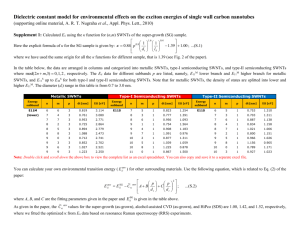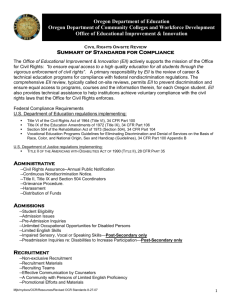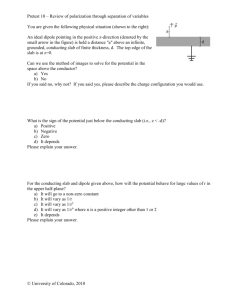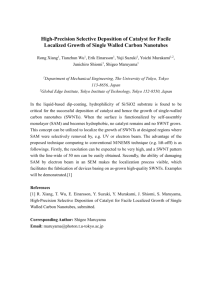Diameter Dependence of the Dielectric Constant for the
advertisement
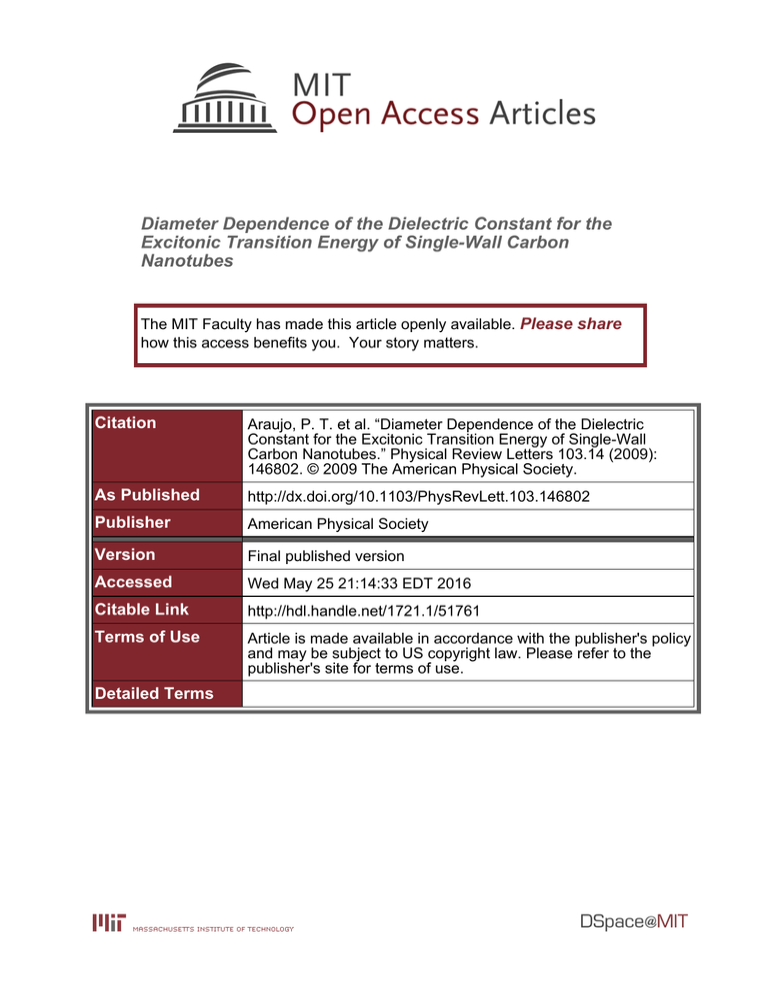
Diameter Dependence of the Dielectric Constant for the Excitonic Transition Energy of Single-Wall Carbon Nanotubes The MIT Faculty has made this article openly available. Please share how this access benefits you. Your story matters. Citation Araujo, P. T. et al. “Diameter Dependence of the Dielectric Constant for the Excitonic Transition Energy of Single-Wall Carbon Nanotubes.” Physical Review Letters 103.14 (2009): 146802. © 2009 The American Physical Society. As Published http://dx.doi.org/10.1103/PhysRevLett.103.146802 Publisher American Physical Society Version Final published version Accessed Wed May 25 21:14:33 EDT 2016 Citable Link http://hdl.handle.net/1721.1/51761 Terms of Use Article is made available in accordance with the publisher's policy and may be subject to US copyright law. Please refer to the publisher's site for terms of use. Detailed Terms PHYSICAL REVIEW LETTERS PRL 103, 146802 (2009) week ending 2 OCTOBER 2009 Diameter Dependence of the Dielectric Constant for the Excitonic Transition Energy of Single-Wall Carbon Nanotubes P. T. Araujo,1 A. Jorio,1,2 M. S. Dresselhaus,3 K. Sato,4 and R. Saito4 1 Departamento de Fı́sica, Universidade Federal de Minas Gerais, Belo Horizonte, MG, 30123-970 Brazil Divisão de Metrologia de Materiais, Instituto Nacional de Metrologia, Normalização e Qualidade Industrial (INMETRO), Duque de Caxias, RJ, 25250-020, Brazil 3 Department of Electrical Engineering and Computer Science, and Department of Physics, Massachusetts Institute of Technology, Cambridge, Massachusetts 02139-4307, USA 4 Department of Physics, Tohoku University, Sendai 980-8578, Japan (Received 14 April 2009; published 30 September 2009) 2 The measured optical transition energies Eii of single-wall carbon nanotubes are compared with bright exciton energy calculations. The Eii differences between experiment and theory are minimized by considering a diameter-dependent dielectric constant , which comprises the screening from the tube S S and from the environment. Different dependencies are obtained for (ES11 , ES22 , EM 11 ) relative to (E33 , E44 ). S S M S S A changing environment changes the diameter dependence for (E11 , E22 , E11 ), but for (E33 , E44 ) the environmental effects are minimal. The resulting calculated exciton energies reproduce experimental Eii values within 70 meV for a diameter range (0:7 < dt < 3:8 nm) and 1:2 < Eii < 2:7 eV, thus providing a theoretical justification for Eii , environmental effects and important insights on the dielectric screening in one-dimensional structures. DOI: 10.1103/PhysRevLett.103.146802 PACS numbers: 73.22.f, 61.48.De, 78.20.-e, 78.67.Ch The last decade has been marked by an impressive development in understanding the nature of the optical transition energies in quasi-one-dimensional single-wall carbon nanotubes (SWNTs) [1], called Eii , where i ¼ 1; 2; 3; . . . denotes the intersubband transitions between the ith valence and the ith conduction band for a given SWNT. While the interest in excitons and dielectric screening in one-dimensional structures dates from research in -conjugated polymers, in carbon nanotubes the large attention started in 2003 with the so-called ‘‘ratio problem’’ [2]. Strong debate still exists about the strength of the exciton binding energy, mostly related to the complex dielectric screening in one-dimensional materials. In 2007, Araujo et al. [3] and Michel et al. [4] showed that the scaling law for the exciton energies explaining the ratio problem [2] breaks down for transitions higher than EM 11 . These results lead to the discussion of the exciton nature for higher energy levels, where quantum-chemistry calculations and solid-state physics (tight binding and firstprinciples) calculations give contradictory pictures [3,5]. Now, the accumulated knowledge in SWNTs, both theoretical and experimental [1], makes it possible to evaluate in detail the dielectric screening in one-dimensional systems. The Eii values are now understood in terms of the bright exciton energy in a framework of a tight binding calculation which includes curvature optimization [1] and manybody effects [1,5,6]. The assignment of Eii for SWNTs over a large region of both diameter (0:7 < dt < 3:8 nm) and Eii (1.2–2.7 eV) values and for a variety of surrounding materials are now available [1], thus making it possible to 0031-9007=09=103(14)=146802(4) accurately determine the effect of the general dielectric constant on Eii . By ‘‘general’’ we mean comprises the screening from the tube and from the environment. In this work we show a dt -dependent effective values for the exciton calculation that are needed to reproduce the experimental Eii values consistently. The results thus obtained are important for the physics of quasi and truly one-dimensional materials and can be used in interpreting optical experiments and environment effects. Figure 1 shows a map of previously reported experimental Eii values (black dots) [7–9] from a SWNT sample grown by the water-assisted (‘‘super-growth’’) chemical vapor deposition method [10–13]. The resulting data for the Eii transition energies are plotted as a function of the radial breathing mode frequencies !RBM , as obtained by resonance Raman spectroscopy (RRS) [7–9,14]. This sample was chosen for the initial analysis developed in this paper because the sample has a homogeneous environment and a large variety of SWNT diameters, as measured by RRS. Furthermore, this sample shows the following features: (i) Experimental observation of the fundamental relation !RBM ¼ 227=dt , for which the constant term B is zero in the relation !RBM ¼ A=dt þ B. The constant term B comes from the interaction of SWNTs with their environment, which is negligible for the present lowdensity SWNT example [7]. (ii) The highest Eii values are obtained for these SWNTs when compared to other samples in the literature [8]. This result indicates that the tubes are surrounded by the lowest environmental dielectric constant (env ! 1) reported in the literature [1,3,4,15–21]. (iii) The previously elusive high energy 146802-1 Ó 2009 The American Physical Society PRL 103, 146802 (2009) PHYSICAL REVIEW LETTERS FIG. 1. Black dots show Eexp ii vs !RBM results obtained from resonance Raman spectra taken from the super-growth SWNT sample [7–9]. The black open circles (semiconducting) and the dark-gray stars (metallic) give Ecal ii for the bright exciton calculation with dielectric constant ¼ 1 [6]. Along the x axis, the Ecal ii points are translated using the relation !RBM ¼ 227=dt [7]. Due to time consumption, only Eii for tubes with dt < 2:5 nm (i.e., !RBM > 91 cm1 ) have been calculated. Transition energies ESii (i ¼ 1 5) stand for semiconducting and EM ii (i ¼ 1, 2) stand for metallic SWNTs. EM ii transitions [18–20] can be observed for metallic SWNTs in these samples [14], indicating the lowest degree of perturbation for metallic tubes as compared to other samples in the literature. In Fig. 1, the experimental values are of Eii vs !RBM for the super-growth sample Eexp ii compared with the calculated bright exciton energies Ecal ii (open circles and stars). Although Ecal ii include SWNT curvature and many-body effects [6], clearly the Eexp ii values are redshifted when compared with theory, and the redshift depends on !RBM , i.e., on dt , and on the optical levels (i in Eii ). The Eii values can be renormalized in the calculation by explicitly considering the dielectric constant in the coulomb potential energy VðqÞ="ðqÞ [22]. Here, represents the screening of the e-h (electron-hole) pair by core ð1sÞ and electrons (tube ) and by the surrounding materials (env ). Here "ðqÞ explicitly gives the polarization function for -electrons calculated within the random phase approximation (RPA) [6,22,23]. To fully account for the observed energy-dependent Eii redshift, we fit the total values (1= ¼ Cenv =env þ Ctube =tube ) to minimize cal Eexp ii Eii . The bullets in Fig. 2 show the fitted values as a function of p=dt , which reproduce each experimental Eii value for the assigned (n, m) SWNTs for the supergrowth SWNT sample. The stars stand for a different SWNT sample, named ‘‘alcohol-assisted’’ SWNTs [24], and they will be discussed below in the next paragraph. The integer p corresponds to the distance ratio of the cutting week ending 2 OCTOBER 2009 FIG. 2. The calculated , which are fitted to the experimental Eii values from the super-growth (bullets) [8,9] and alcoholassisted (stars) [3,9] samples. (a) ES22 (black) and EM 11 (dark gray). The dashed and dotted curves are given by Eq. (1) with C ¼ 0:75 and 1.02, respectively. (b) ES33 (black) and ES44 (dark gray). The dashed curve is for Eq. (1) with C ¼ 0:49. lines from the K point, where p ¼ 1, 2, 3, 4 and 5 stands S S for ES11 , ES22 , EM 11 , E33 , and E44 , respectively [1]. Thus p=dt represents the distance of the k point from the K point in the two-dimensional Brillouin zone of graphene. Consideration of p=dt allows us to compare the values of SWNTs with different dt and different Eii using the same plot. As seen in Fig. 2, the values increase with increasing p=dt for different Eii values. The values for ES33 and ES44 [Fig. 2(b)] appear in a smaller region than those for ES11 and ES22 [Fig. 2(a)]. To gain more insight into the influence on the optical transition energies, Fig. 3 shows a comparison between the Eexp ii from the super-growth SWNT sample (bullets) [8] and FIG. 3. Eexp vs !RBM results obtained for the super-growth ii (bullets) [8,9] and alcohol assisted (open circles) [3,9] SWNT samples. 146802-2 PRL 103, 146802 (2009) PHYSICAL REVIEW LETTERS from the ‘‘alcohol-assisted’’ SWNT samples (open circles) [3]. The alcohol-assisted SWNT sample is chosen for comparison for three reasons: (i) this sample also has a broad diameter distribution (0:7 < dt < 2:3 nm); (ii) the observed Eii are similar to many other samples in the literature [8]; (iii) the sample is morphologically similar to the super-growth sample (both are carpetlike free standing SWNTs). From Fig. 3, we see that the Eexp ii values from the ‘‘alcohol-assisted’’ SWNTs are generally redshifted with respect to those from the super-growth SWNTs. Assuming that tube does not change from sample to sample, since the structure of a given (n, m) tube should be the same, these results indicate that the alcohol-assisted SWNTs are surrounded by a larger env value, thus increasing the effective and decreasing Eii . Looking at Fig. 2 we can observe the difference in the values resulting from fitting the Eexp ii to the super-growth (bullets) in comparison to alcohol-assisted (stars) SWNT samples. For ES22 and EM 11 [Fig. 2(a)], we see a clear difference for up to p ¼ 3 when comparing the two samples. However, for ES33 and ES44 [Fig. 2(b)], no difference in between the two samples can be seen. This means that the electric field of the ES33 and ES44 excitons do not extend much outside the SWNT volume, in contrast to the ES22 and EM 11 excitons for which the env effect is significant. Since the effect of env is relatively small for energies above EM 11 , it is possible to assign the (n, m) values from ES33 and ES44 if the dielectric constant of the environment is not known, even though the ES33 and ES44 values are seen within a large density of dots in the Kataura plot. In constructing Fig. 2, we used the relation 1:7 p ¼ C ; (1) dt where the exponent 1.7 was found to work for all Eexp ii , but different C parameters are needed. For ES11 , ES22 and EM 11 , C ¼ 0:75 for the super-growth SWNTs and C ¼ 1:02 for the alcohol-assisted SWNTs (dashed and dotted curves in Fig. 2(a), respectively). The ES33 and ES44 are fitted using C ¼ 0:49 for both samples, as shown by the dashed line in Fig. 2(b). Figure 4 summarizes the effect of our -based renormalization of Eii . In Fig. 4 we plot the energy differcal ence Eii ¼ Eexp ii Eii as a function of dt for (a) values fixed to be equal to 1 ( ¼ 1), (b) values fixed to be equal to 2.22 ( ¼ 2:22), broadly used in the literature [1] and (c) the diameter-dependent values using the function of Eq. (1), including both the super-growth SWNTs and the alcohol-assisted SWNTs. From Figs. 4(a) and 4(b) we observe that the fitting results using fixed values for are not good enough from a physical point of view, because the data in these figures are spread over a window of about 400 meV, which is greater than the observed resonance window for a single (n, m) tube [1]. Besides, the spread of the Eii points in Figs. 4(a) and 4(b) increases for small dt tubes. To address this physical inconsistency, we analyze week ending 2 OCTOBER 2009 cal FIG. 4. The difference Eii ¼ Eexp ii Eii as a function of dt for (a) ¼ 1, (b) ¼ 2:22 and (c) the diameter-dependent given by Eq. (1). Closed stars (EM 11 for metallic tubes), closed bullets (ES11 and ES22 for semiconducting tubes) and open bullets (ES33 and ES44 for semiconducting tubes) stand for super-growth data, while open stars (EM 11 for metallic tubes), closed squares (ES11 and ES22 for semiconducting tubes) and open squares (ES33 and ES44 for semiconducting tubes) stand for alcohol-assisted data. cal cal the energy difference Eii ¼ Eexp ii Eii , where Eii is now calculated by considering given by Eq. (1). When the resulting Eii is plotted vs dt for all Eii (p ¼ 1; . . . ; 5), using the C parameters given in the text, all the Eii in Fig. 4(c) deviate from zero by less than 70 meV, for both the super-growth and the ‘‘water-assisted’’ SWNT samples, over the entire dt region. Qualitatively, the origin of the diameter dependence presented by Eq. (1) consists of: (i) the exciton size and (ii) the amount of electric field ‘‘feeling’’ the dielectric constant of the surrounding material. These two factors are connected and the development of an electromagnetism model is needed to fully rationalize this equation. Interestingly, the similarity between the values found for ES22 and EM 11 shows that the difference between metallic and semiconducting tubes is satisfactorily accounted by the 146802-3 PRL 103, 146802 (2009) PHYSICAL REVIEW LETTERS RPA in "ðqÞ [5]. Also interesting is the different behavior observed for higher levels (p > 3), where C is smaller than for Eii with p 3, and it is independent of the sample environment. Again, two pictures can be given: (1) the more localized exciton wave function (a larger exciton binding energy) for ES33 and ES44 compared with EM 11 and ES22 , leads to smaller and a lack of a env dependence of the wave functions for the ES33 and ES44 excitons; (2) stronger tube screening (tube ) leads to an independence in env and, consequently, a smaller effective . In summary, we have shown that the diameter-dependent dielectric constants following Eq. (1) reproduce the measured Eii values well for a large region of energy (1.2– 2.7 eV) and tube diameter (0.7–3.8 nm). The present treatment for is sufficiently accurate for assigning both the 2n þ m family numbers and the (n, m) SWNTs belonging to each family for different SWNT samples, for the supergrowth and alcohol-assisted samples used for establishing the model system of this Letter. All the observed Eii vs (n, m) values are now theoretically described within experimental precision, considering use of the extended-tight binding model along with many-body corrections plus a diameter-dependent dielectric constant , as established in the present work [Eq. (1)]. The empirical exponent 1.7 is not yet fully understood, and theoretical modeling considering the role of effective mass is under way. The results presented here are also consistent with the previously published empirical methodology of Ref. [3], and therefore provide the theoretical justification for it. Having justified this empirical methodology, the findings of the present work have the following implications on taking account of environmental effects for fitting the measured dt dependence of !RBM for an arbitrary experimental sample. Using the results of the empirical methodology of Ref. [3], the measured !RBM ðdt Þ for an arbitrary experimental sample is fitted to the formula qffiffiffiffiffiffiffiffiffiffiffiffiffiffiffiffiffiffiffiffiffiffiffiffiffi !RBM ¼ ð227=dt Þ 1 þ Ce d2t ; (2) where only a single parameter (Ce ) is used to account for the observed dt -dependent environmental effects. For the case of the super-growth SWNTs we have a fit to the Eexp ii data for Ce ¼ 0 [7], while for the alcohol-assisted sample, the fit is accomplished by Ce ¼ 0:057. However, for an arbitrary sample measured in the laboratory, a least squares fit is made by the researchers themselves to determine the best fit value for Ce in Eq. (2) to their experimental data. In this way the results of this paper can be extended to yield a fit of !RBM ðdt Þ to arbitrary samples in a metrological sense, based on a single fitting parameter Ce to account for the experimental environmental effect measured for their sample by the resonance Raman effect. week ending 2 OCTOBER 2009 P. T. A. and A. J. acknowledge financial support by FAPEMIG, Rede de pesquisa em nanotubos de carbono MCT/CNPq and AFOSR. M. S. D. acknowledges support from NSF grant DMR07-04197. K. S. is supported by a JSPS research grant (No. 20-4594). R. S. acknowledges support from MEXT Grants (No. 20241023). [1] A. Jorio, M. S. Dresselhaus, and G. Dresselhaus, Carbon Nanotubes: Advanced Topics in the Synthesis, Structure, Properties and Applications Springer Series on Topics in Appl. Phys. 111 Vol. 111 (Springer-Verlag, Berlin, 2008). [2] C. L. Kane, and E. J. Mele, Phys. Rev. Lett. 90, 207401 (2003). [3] P. T. Araujo et al., Phys. Rev. Lett. 98, 067401 (2007). [4] T. Michel et al., Phys. Rev. B 75, 155432 (2007). [5] K. Sato et al., Phys. Rev. B 76, 195446 (2007). [6] J. Jiang et al., Phys. Rev. B 75, 035407 (2007). [7] P. T. Araujo et al., Phys. Rev. B 77, 241403(R) (2008). [8] P. T. Araujo and A. Jorio, Phys. Status Solidi B 245, 2201 (2008). [9] See EPAPS Document No. E-PRLTAO-103-022942 for an example of the resonant Raman spectral profile of the carpetlike water-assisted CVD grown SWNTs ranging from 65 cm1 to 4550 cm1 . In addition, file EpapsAraujo-EiiKappaTable.xls brings the experimental !RBM , Eii and the values fitting Eii for the samples analyzed in our Letter. For the alcohol-assisted sample we present experimental results for 84 different (n, m) SWNTs, including Eii values for ES22 , EM 11 (lower branch), ES33 and ES44 . For the water-assisted sample we present experimental values for 176 different (n, m), including Eii M values for ES11 , ES22 , EM 11 (lower branch), E11 (higher S S M M branch), E33 , E44 , E22 (lower branch), E22 (higher branch), ES55 and ES66 . For more information on EPAPS, see http:// www.aip.org/pubservs/epaps.html. [10] K. Hata et al., Science 306, 1362 (2004). [11] D. N. Futaba et al., Phys. Rev. Lett. 95, 056104 (2005). [12] D. N. Futaba et al., J. Phys. Chem. B 110, 8035 (2006). [13] D. N. Futaba et al., Nature Mater. 5, 987 (2006). [14] S. K. Doorn, P. T. Araujo, K. Hata, and A. Jorio, Phys. Rev. B 78, 165408 (2008). [15] M. Milnera, J. Kürti, M. Hulman, and H. Kuzmany, Phys. Rev. Lett. 84, 1324 (2000). [16] S. M. Bachilo et al., Science 298, 2361 (2002). [17] M. Y. Sfeir et al., Science 312, 554 (2006). [18] S. K. Doorn et al., Appl. Phys. A 78, 1147 (2004). [19] C. Fantini et al., Phys. Rev. Lett. 93, 147406 (2004). [20] H. Telg et al., Phys. Rev. Lett. 93, 177401 (2004). [21] A. Débarre et al., Phys. Rev. Lett. 101, 197403 (2008). [22] Y. Miyauchi et al., Chem. Phys. Lett. 442, 394 (2007). [23] V. Perebeinos, J. Tersoff, and Ph. Avouris, Phys. Rev. Lett. 92, 257402 (2004). [24] Y. Murakami, E. Einarsson, T. Edamura, and S. Maruyama, Carbon 43, 2664 (2005). 146802-4
